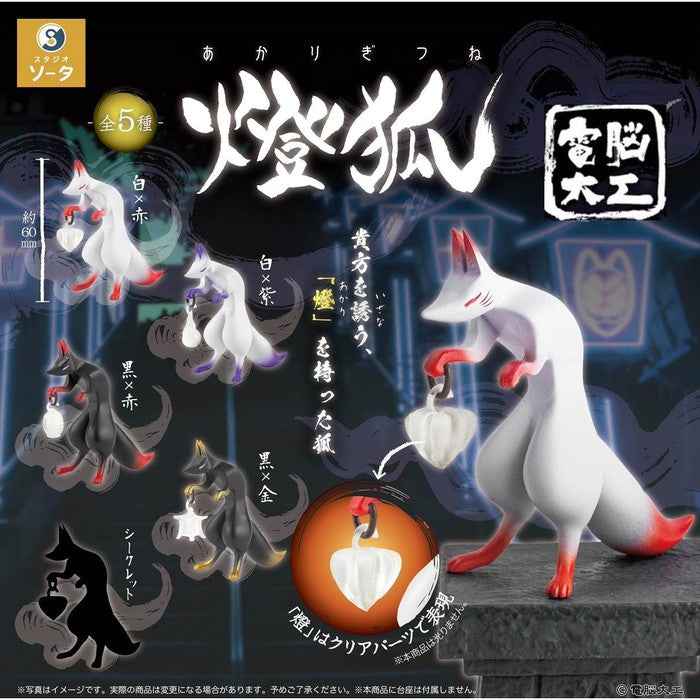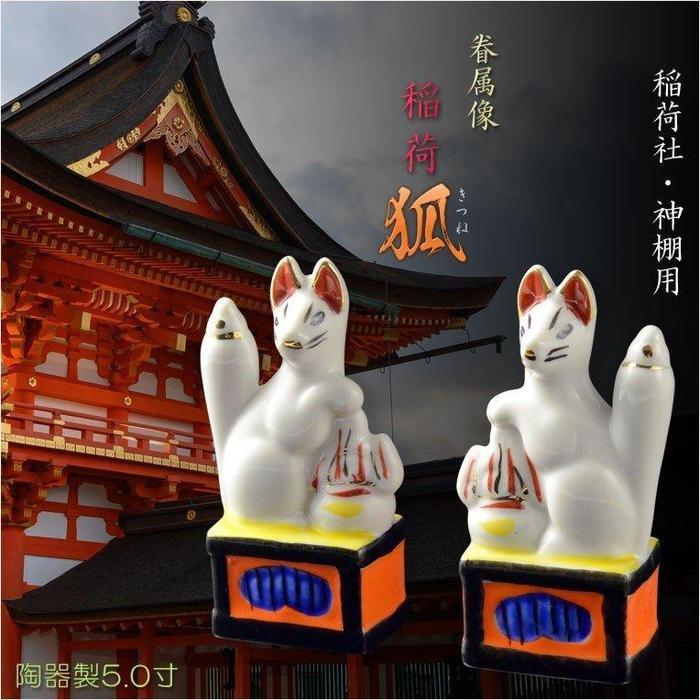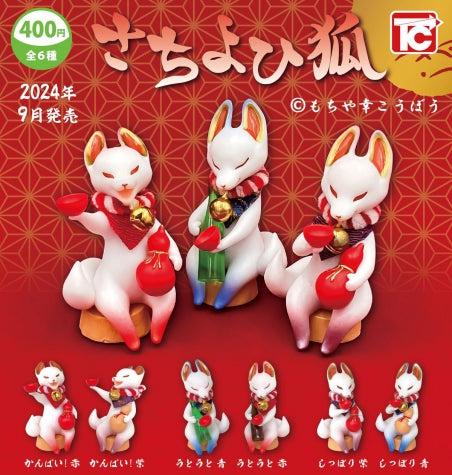What is a Kitsune? Discover the Japanese Mystical Fox
The word Kitsune (狐) means "fox" in Japanese, but in Japanese folklore, a Kitsune is not just an ordinary fox. It is a powerful, mystical being known for its shape-shifting abilities, intelligence, and close connection to the Shinto deity Inari. This fascinating fox spirit is an important figure in Japanese culture, appearing in traditional stories, art, and even in modern media. In this article, you'll learn what a Kitsune is, its origins, the different types, and the role it plays in contemporary Japanese culture.
Origin of the Kitsune
The legend of the Kitsune dates back over a thousand years and has its roots in both Shinto beliefs and Chinese mythology. These fox spirits are considered to be messengers of Inari Ōkami, the Shinto deity responsible for rice, fertility, and prosperity. Inari shrines often depict foxes as statues, emphasizing their spiritual connection to the deity.
In Japan, the Kitsune became sacred due to this close association with Inari. Over time, it developed its own identity within Japanese folklore. Legends often describe Kitsune as highly intelligent beings with shape-shifting abilities, commonly transforming into humans, usually beautiful women. This unique combination of characteristics made the Kitsune a central figure in Japanese folklore, symbolizing mystery, cunning, and supernatural power.
As Kitsune stories spread and evolved, they became prominent in Japanese art, literature, and theater, leaving a cultural legacy that continues to inspire modern interpretations in media such as books, anime, and movies.
Are fox spirits classified?
In Japanese folklore, fox spirits are classified according to their divine status. From highest to lowest, these are: Tenkō, Senkō, Kūkō, Kikō, and Yakō. In short, Tenkō is a deity, while Yakō is a lower-ranking spirit associated with malevolence. This classification originates from the Edo period and was described by the Confucian scholar Kinen Minagawa. Numerous interpretations have been derived from his writings.
Tenkō (天狐)

Tenkō is a fox that lives for a thousand years, possessing clairvoyant abilities and immense spiritual power. It is a nine-tailed fox that has become a god. At Fushimi Inari Taisha in Kyoto, there is a Tenkō named Kosusuki. In Chinese texts, such as Xuanzhongji and Wuzazu, it is described as a spiritual fox that, over a thousand years, transformed into a beautiful woman and absorbed human energy to achieve divine power.
Kūkō (空狐)

Kūkō is a fox that has lived for a thousand years and possesses spiritual abilities. It is said to be able to travel a thousand li (a traditional Chinese unit of distance) in the blink of an eye. After three thousand years, the fox transforms into what is called an Inari Kūko. Upon becoming Kūko, it loses its physical body and exists as a spirit. It is considered one rank below Tenkō in the hierarchy.
Kikō (気狐)

Kikō is a fox in the process of spiritual learning that has not yet reached the level of Tenkō or Senkō. It is usually between five hundred and a thousand years old. Fox spirits that are learning spiritual arts undergo transformations and change the number of their tails. Most of them are white or black foxes that serve Inari. The twin fox statues at Inari shrines symbolize Kikō.
Yakō (野狐)

Yakō is a malevolent fox that can possess people, induce visions, cause illnesses, and bring misfortune. In the hierarchy of fox spirits, it is at the lowest level and is regarded as a sinister spirit that is drawn to people with hostile intentions.
Senkō (仙狐)

Senkō is a fox that has attained spiritual abilities through study and practice. In some interpretations, it is equated with Kūko. Foxes that wish to become Senkō learn spiritual arts from older foxes in caves and must pass special tests. If they fail, they become lower-ranking spirits, which drives them to work intensively.
Shinkō (辰狐)

Also known as Dakiniten (荼枳尼天), Shinkō is a Buddhist deity regarded as a type of yaksha. In Japan, it is often associated with the cult of Inari and is depicted as a celestial being riding on a white fox. Accompanying it are fox spirits called Yakan, which in China are represented as unknown creatures resembling foxes, but in Japan, they are unequivocally identified with foxes.
Kitsune in Japanese Culture and Contemporary Media
Duch Kitsune przeniknął nie tylko tradycyjny folklor, ale również współczesną kulturę popularną. Wiele anime, mang i gier wideo zawiera postaci Kitsune lub tematy inspirowane tymi mistycznymi stworzeniami. Popularne serie, takie jak Naruto i Pokémon, mają postaci oparte na Kitsune, co świadczy o ich nieustającej popularności.
Maski i motywy Kitsune są również powszechnie widoczne na japońskich festiwalach. Słynna świątynia Fushimi Inari w Kioto jest poświęcona duchowi lisa i każdego roku odwiedzają ją miliony ludzi. Jest to jedno z najbardziej ikonicznych miejsc w Japonii, z tysiącami czerwonych bram torii i niezliczonymi posągami lisów oddających cześć Inari i jego posłańcom.
Symbol of Kitsune
The spirit of the Kitsune has permeated not only traditional folklore but also contemporary popular culture. Many anime, manga, and video games feature Kitsune characters or themes inspired by these mystical creatures. Popular series such as Naruto and Pokémon include characters based on Kitsune, highlighting their enduring popularity.
Kitsune masks and motifs are also commonly seen at Japanese festivals. The famous Fushimi Inari Shrine in Kyoto is dedicated to the fox spirit and attracts millions of visitors each year. It is one of the most iconic places in Japan, with thousands of red torii gates and countless fox statues honoring Inari and his messengers.
Experience the Kitsune Culture for Yourself
If you are fascinated by Kitsune, consider visiting a local Inari shrine or purchasing our Kitsune figurine from a gacha gacha (capsule toy).
Bringing a Kitsune figurine home is also a popular way to honor the spirit and its protective qualities.

Yokai Kitsune Gacha-Gacha Capsule Toy - Random

Set of two hand-painted Zenko foxes (Altar decoration)

Sachi Yohi kitsune Gacha-Gacha Capsule Toy

O nas
Wabi Sabi Store to sklep internetowy założony przez Tsukawaki Emi z kanału Ja Ci Dam Japonia. Oferujemy tylko oryginalne japońskie produkty o najlepszej jakości. W naszej ofercie znajdą Państwo japońskie kosmetyczne hity niedostępne na europejskim rynku, najpopularniejsze japońskie przekąski, rękodzieło, yukaty i wiele innych produktów. Nasz sklep powstał z miłości do Japonii i chęci promowania jej kultury i tradycji, dlatego serdecznie zapraszamy do zakupów oraz dzielenia się z nami sugestiami dotyczącymi produktów, których oczekują Państwo w naszej ofercie.
Zostaw ocenę produktu
Twoje opinie mają ogromne znaczenie, nie tylko dla nas, ale także dla całej społeczności WabiSabi. Każda ocena, którą zostawiasz, pomaga innym klientom lepiej zrozumieć nasze produkty, co przekłada się na bardziej świadome zakupy.
Dzięki Twoim recenzjom możemy stale ulepszać naszą ofertę i dostarczać produkty, które naprawdę odpowiadają na potrzeby naszych klientów. Twoje oceny to nieocenione źródło informacji – zarówno dla nas, jak i dla osób, które zastanawiają się nad zakupem.
Dziękujemy, że dzielisz się swoimi doświadczeniami!











